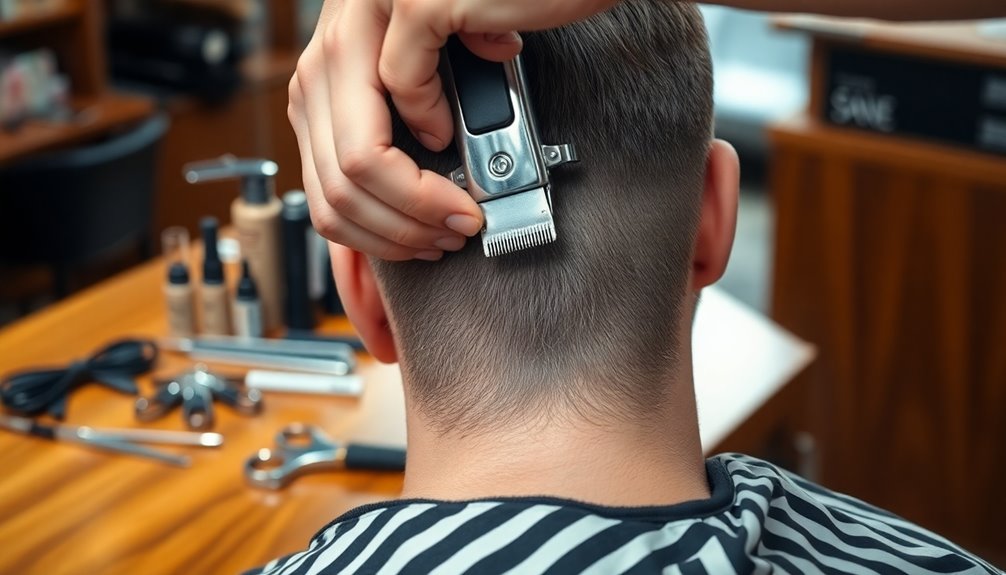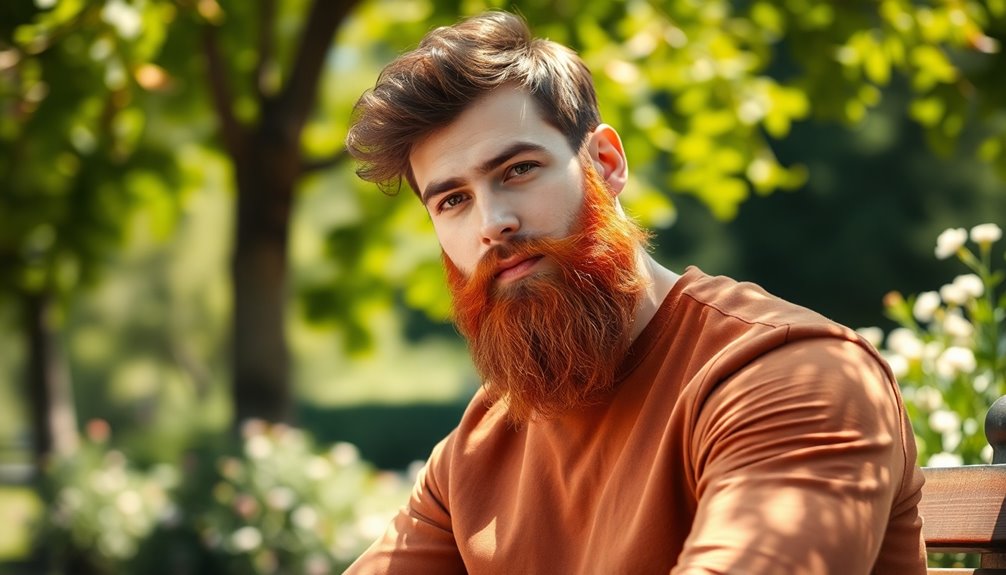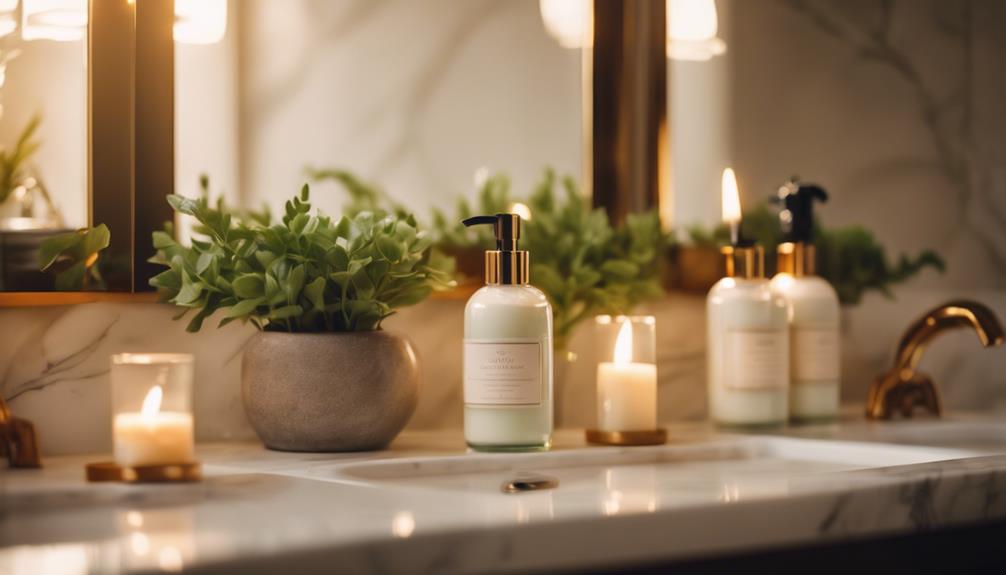When you're choosing between a 1 fade and a 2 fade, consider the look you want to achieve. A 1 fade is shorter, starting closer to the scalp, creating a sharper, cleaner appearance. It works well for a striking, modern style, while a 2 fade offers a slightly longer transition, providing a softer, more blended effect. Both styles can enhance your features, but it's essential to communicate your hair type and desired outcome clearly with your barber. If you're eager to learn more about styling, maintenance, and choosing the right fade for your face shape, keep exploring!
Key Takeaways
- A "1 fade" typically starts with the clippers set to a #1 guard, while a "2 fade" uses a #2 guard for longer, softer transitions.
- The choice between a 1 and 2 fade influences the overall appearance, with a 1 fade offering a more dramatic contrast.
- A skilled barber can customize fades to suit face shape, hair type, and personal style preferences for optimal results.
- Communication with your barber about desired fade type and length is crucial for achieving the perfect cut.
- Visual references can help clarify your fade preferences, ensuring better understanding and execution during the haircut.
Understanding Fade Types
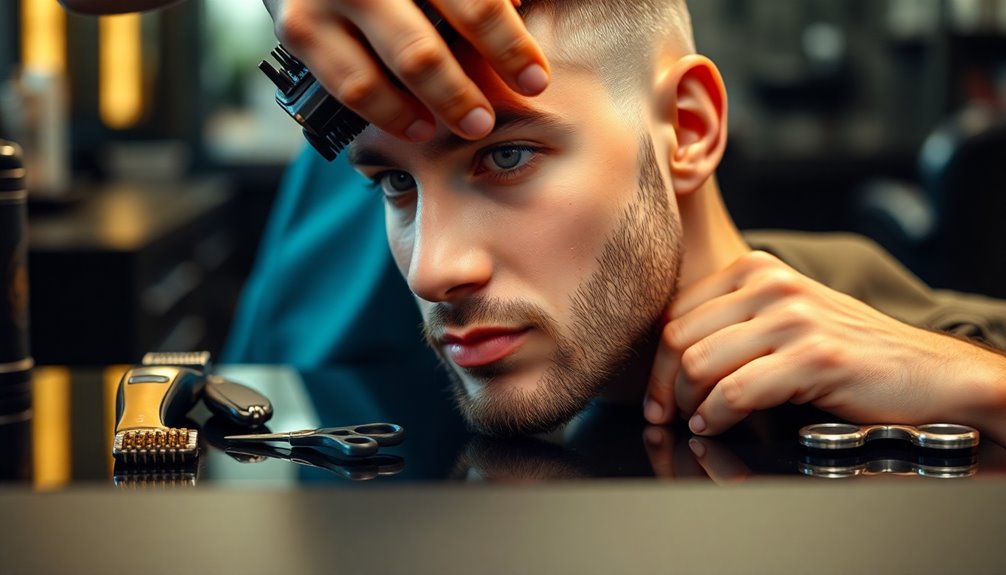
When it comes to achieving the perfect haircut, understanding fade types is essential. Fades come in various styles, each offering a unique look tailored to your personal preference.
A low fade starts just above your ears, closely trimming the hair on the back and sides. This style provides a clean, understated appearance, allowing the hair on top to be longer, making it versatile for styles like a side part or quiff. The tapering technique used in low fades creates a subtle transition that enhances the overall look.
Mid fades begin around the midpoint of the sides, striking a balance between subtle and bold. It suits various face shapes and hair types, making it a popular choice for modern hairstyles like the textured crop.
If you're looking for something edgier, a high fade starts near the crown, creating a dramatic contrast between the longer hair on top and shorter sides. This fade often pairs well with styles like the pompadour, giving you a striking look.
There are specialized fades too, like the drop fade or skin fade, each offering distinctive features that can enhance your overall style. Understanding these options will help you communicate your desired look to your barber effectively.
The Art of Fade Techniques
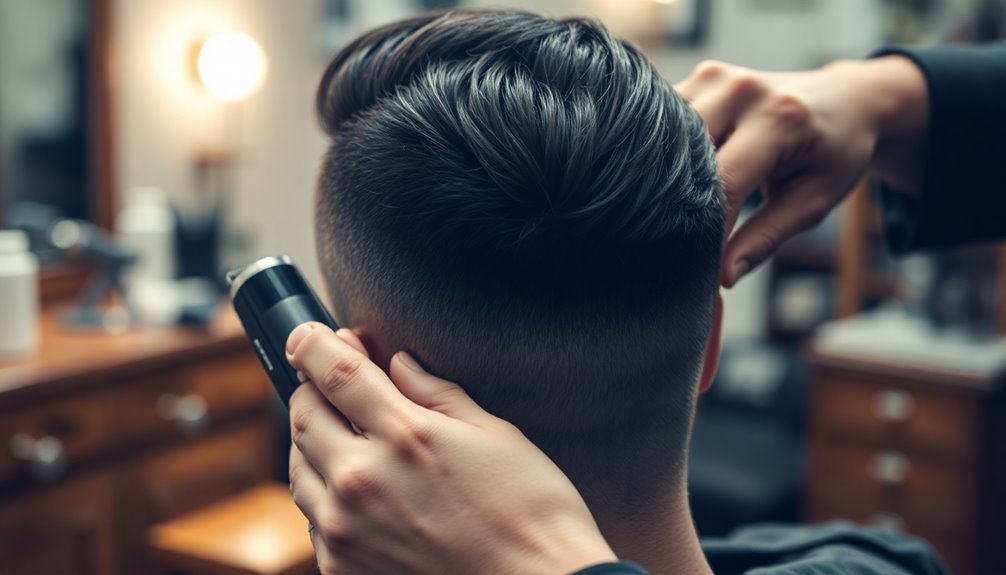
Mastering the art of fade techniques requires a blend of skill, practice, and the right tools. You need high-quality clippers with adjustable blades for precision, along with a variety of guard sizes to control hair length. Tapered combs are essential for blending different lengths smoothly, while scissors help refine the fade and detail the cut. Don't forget compact trimmers for shaping those sharp edges.
When it comes to techniques, bottom-up fading gives you control over buildup and balance, especially for thick or ethnic hair. Top-down fading can be tricky, but it creates a nice blend. The taper technique offers a gradual transition, making your fade look polished. Remember to use a flicking motion with clippers to avoid harsh lines. Additionally, understanding the four main variations of fades can help you choose the perfect style for your client.
Start by establishing a clean baseline with the shortest guard. Gradually increase the guard size, moving up the head for a seamless transition. Regularly check your work with a comb to ensure evenness, and apply advanced blending techniques to eliminate any lines. With practice and the right approach, you'll master the fade and create stunning hairstyles every time.
Choosing Your Top Style
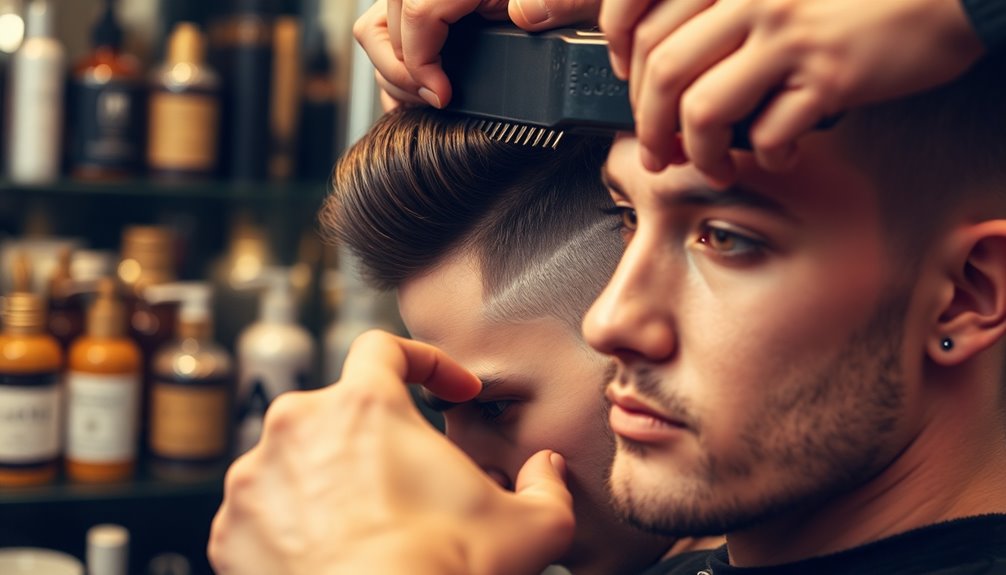
Choosing your top style can transform your look and boost your confidence. When considering a fade, it's essential to understand the different types available. A low fade starts close to the ear, providing a subtle transition, while a mid fade strikes a balance between low and high. If you want a more dramatic flair, opt for a high fade that begins higher up on the sides. For a sleek appearance, the skin fade cuts hair close to the skin.
Next, think about your face shape and hair texture. A skilled barber knows how to customize your cut to flatter your unique features and work with your specific hair type, whether curly, wavy, or straight. This ensures you get a style that reflects your personal and professional image, while also showcasing their commitment to quality.
Lastly, evaluate the barber's expertise. Look for someone with experience, a diverse portfolio of styles, and a confident technique. Clear communication is vital, so make sure your barber actively listens to your preferences. By choosing the right top style and collaborating with an expert, you'll achieve a look that not only enhances your appearance but also makes you feel great!
Sideburns and Neckline Options
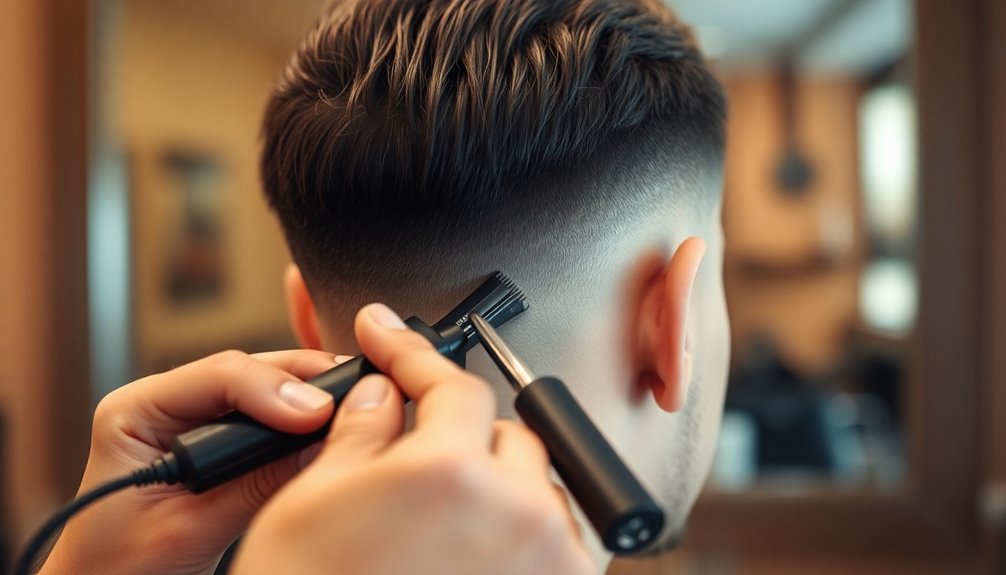
Sideburns and necklines play a crucial role in defining your overall haircut and enhancing your style. When you choose a taper fade, you'll notice how it focuses on both the neckline and sideburn area, offering a low-maintenance option. The gradual transition from short hair on the sides to longer hair on top creates a natural look, but it's important to match the taper on your sideburns with the nape for a cohesive finish. Additionally, the versatile and adaptable nature of taper fades allows for customization that caters to individual preferences and face shapes.
For necklines, you have several options. A taper neckline follows your natural hairline and grows out neatly, while a rounded neckline can make thin necks appear thicker. If you've got a wider neck, consider a blocked neckline, but be ready for more maintenance. High fades offer a sharp look but might require frequent trims.
When styling, think about how your sideburns flow with your overall haircut. Integrating your beard with your fade can also enhance your style. Ultimately, the right sideburn and neckline combination can elevate your fade, making it a true reflection of your personality.
Essential Styling Products
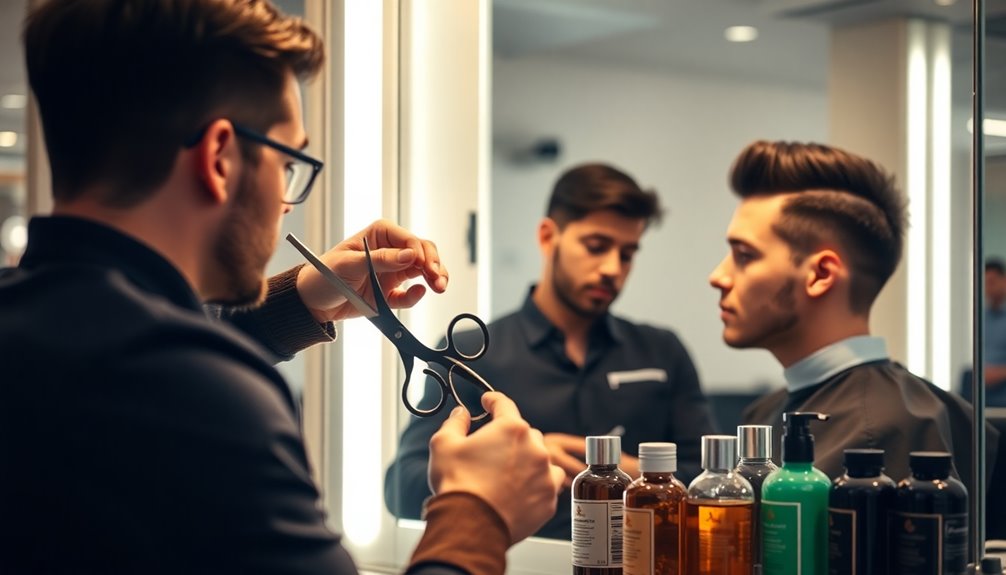
To achieve the perfect fade, using the right styling products is essential. Start with gentle shampoos like Head & Shoulders or Dove to keep your scalp and hair clean. Follow up with a moisturizing conditioner such as Pantene or Shea Moisture to maintain hydration. Regular washing is key to keeping your fade looking fresh, so choose products that suit your hair type to avoid irritation.
Light hair oils like Argan or Coconut Oil are fantastic for keeping your hair and scalp healthy. They help maintain shine, especially with skin fades, while lightweight moisturizers protect your scalp from environmental damage. For styling, turn to gels from brands like American Crew or Suavecito to hold your style in place. If you prefer a lighter touch, opt for pomades or styling creams that won't weigh your hair down. Additionally, choosing the right fade type can greatly enhance your overall haircut style.
For added texture, consider Sea Salt Sprays or Texture Sprays to enhance volume. Hair Styling Powders or light creams can provide the hold you need without sacrificing the fade's sleekness. With the right products, you'll elevate your fade and keep it looking sharp all day long.
Maintenance and Trim Guidelines
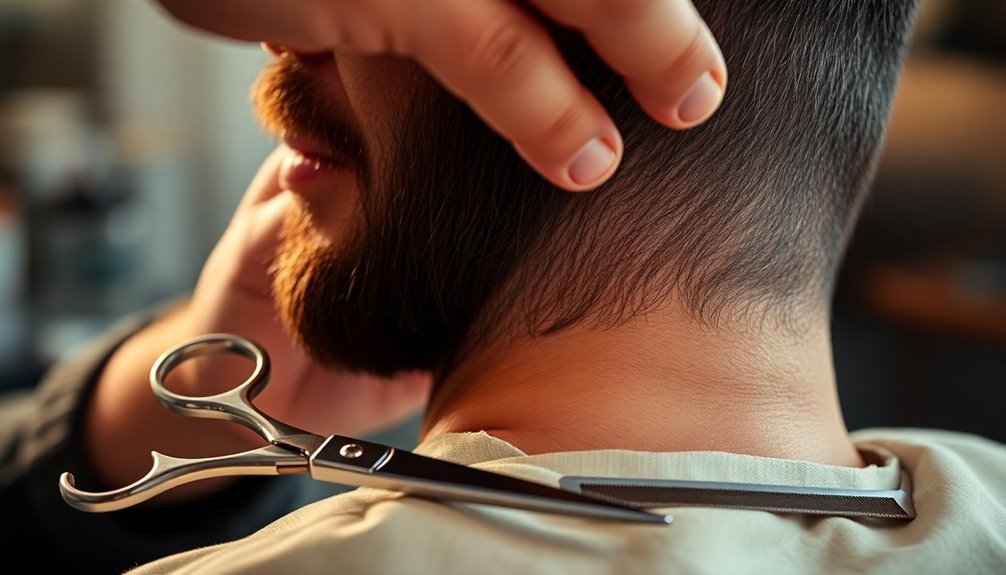
Maintaining a fresh fade requires regular trims and attentive care. To keep your fade sharp, schedule trims every 2-4 weeks. If you prefer a shorter look, aim for every 2-3 weeks; for a longer style, every 4-6 weeks will suffice. Regular trims not only prevent uneven growth but also maintain those clean lines and seamless transitions that make a fade stand out.
At home, you can touch up the fade using clippers between barber visits. Use trimmers or razors to clean up your hairline and keep it looking sharp. A comb or brush will help you maintain a neat appearance, and don't forget to hydrate your scalp to avoid dryness. Regular trimming is essential to manage length and shape of the fade effectively. Additionally, keeping your hair well-groomed can also contribute to overall health by reducing stress and promoting a sense of well-being.
Wash your hair 2-3 times a week with a gentle shampoo and conditioner to preserve natural oils. Avoid hot water; lukewarm is best. Protect your hair from heat and sun damage with appropriate products, and consider dry shampoo for in-between washes.
Communicating With Your Barber
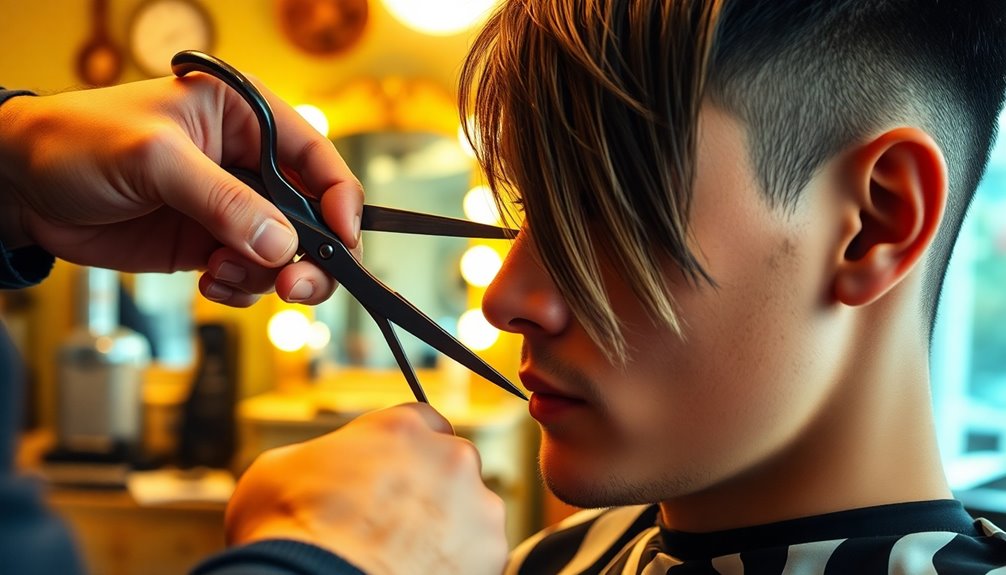
Effective communication with your barber is essential for achieving the haircut you envision. Start by clearly discussing the type of fade you want—whether it's bald, skin, or shadow. Specify where you'd like the fade to start, using precise language like clipper guard numbers to avoid any confusion. Your barber needs to understand your hair type and face shape to tailor the cut effectively.
Building trust is crucial, too. Listen actively to your barber's feedback and express your preferences openly. Use your barber's name during the conversation to create a personal connection. This small gesture shows you value their expertise. Additionally, be sure to arrive with a general idea of your desired hairstyle to facilitate a more productive discussion.
Don't hesitate to ask for guidance. Your barber can offer styling tips, maintenance advice, and recommend suitable products to help you achieve the desired look at home. Discuss any specific concerns you have, such as a sensitive scalp or areas that need extra attention.
Lastly, be open about any evolving style preferences. This dialogue helps manage expectations based on your hair texture and growth patterns, ensuring you leave the chair feeling satisfied. Remember, effective communication is the key to a perfect cut!
Visual Examples and References
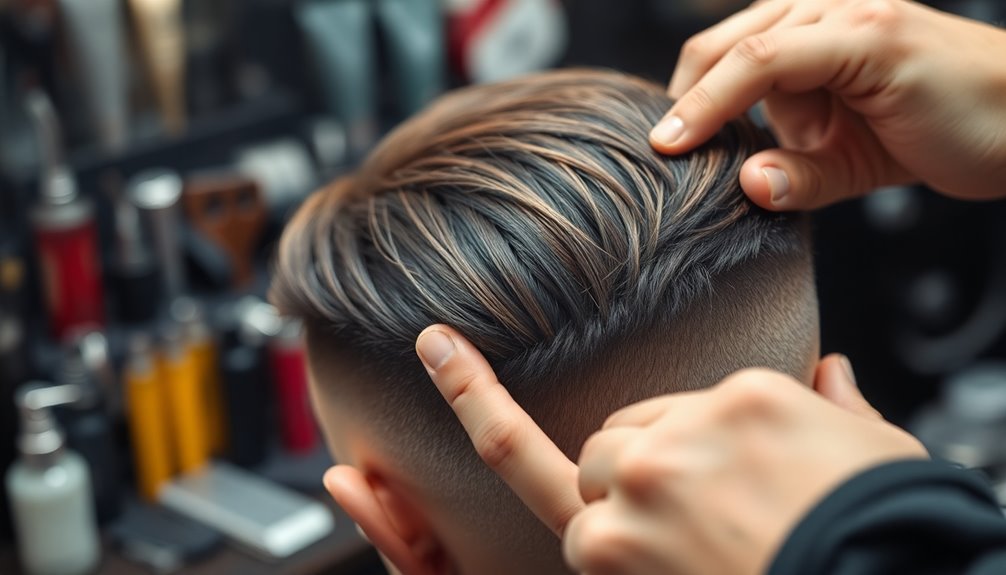
Visual clarity plays a vital role in achieving your ideal haircut. Using reference photos can bridge the gap between what you envision and what your barber executes. These images provide exact style representation, ensuring your barber understands the fade height you desire. By sharing photos, you reduce the chances of miscommunication, leading to a more satisfying result.
Reference images also highlight crucial details, such as blend points and transition smoothness. This specificity helps your barber create a cut that complements your face shape. For instance, if you have an oval face, a mid fade may work well, while a high fade suits square or oblong shapes better. Additionally, fade haircuts can be tailored to various hair types and face shapes, allowing for a versatile selection that enhances your unique features.
Visual examples inspire styling options for the top hair, whether you prefer a pompadour, quiff, or textured crop. Each type of fade—high, low, mid, burst, or skin—has distinct visual characteristics that can guide your choice. By clearly communicating your desires with visual references, you set the stage for a haircut that matches your style perfectly, ensuring you walk out of the barbershop feeling confident and satisfied. In addition to choosing a fade, consider incorporating highlights to elevate your look further. Techniques such as celebrityinspired babylights techniques can add dimension and richness to your hairstyle, allowing for a fresh and modern appearance. Remember to ask your barber or stylist for advice on how these elements can best complement your face shape and personal style, ensuring a tailored result that enhances your overall aesthetic.
Frequently Asked Questions
How Do I Choose the Right Fade for My Face Shape?
To choose the right fade for your face shape, start by identifying your features. If you have an oval face, go for a low or mid fade to enhance symmetry. Round faces benefit from high or drop fades for added height. Square faces look great with mid or high fades to soften angles. For rectangular shapes, consider low or drop fades to balance proportions. Always avoid fades that exaggerate your face's natural shape!
Can I Get a Fade With Medium-Length Hair?
Yes, you can definitely get a fade with medium-length hair! A mid taper fade works particularly well, as it gradually shortens the sides and back while keeping the top longer. This creates a balanced look that's stylish yet low-maintenance. It suits various hair types and textures, allowing for versatility in styling. Just remember to maintain it with regular trims and proper hair care to keep it looking sharp.
What's the Difference Between a Fade and a Taper?
A fade and a taper both involve gradually shortening hair, but they differ significantly. When you get a fade, your hair is shaved close to the skin, creating a more dramatic look. In contrast, a taper keeps hair longer on the sides, following your natural hairline without going as short. Fades are often bolder and casual, while tapers are more conservative, making them suitable for professional settings. Choose based on your style preference!
How Do I Maintain My Fade at Home?
To maintain your fade at home, trim it every 2-4 weeks, depending on your hair growth. Use clippers or trimmers for touch-ups on your sideburns and neckline. Wash your hair regularly with a sulfate-free shampoo and condition to keep it soft. Style it with a strong hold gel or pomade for a polished look, and protect it while you sleep with a satin pillowcase. Avoid DIY fixes to keep your fade looking sharp.
Are Fades Suitable for Curly or Textured Hair?
Yes, fades are definitely suitable for curly or textured hair! They create a striking contrast between your curls on top and the shorter sides, enhancing your natural texture. Depending on your face shape and curl type, you can choose from low, mid, high, or skin fades. These styles not only look modern and clean but also make maintenance easier, allowing you to enjoy a stylish and balanced appearance with minimal effort.
Conclusion
In the world of fades, mastering the right technique can elevate your hairstyle to new heights. Whether you opt for a 1 fade or a 2 fade, remember that communication with your barber is key to achieving your desired look. Keep your style fresh with the right products and regular trims. Embrace the artistry involved in fading, and don't hesitate to explore different options until you find the perfect cut that suits your personality and lifestyle.
